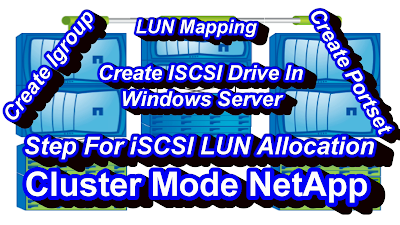How To Create iSCSI LUN And Discover In Windows Host Netapp Cluster Mode
Today we will discuss how we can create iscsi LUN in SVM NetApp Cluster Mode and allocate it to a Windows Host. In previous video we discussed how to configure iSCSI in SVM Netapp Cluster Mode. Click here to know more about it. Below are the overall steps need to perform in order to create iSCSI LUN in SVM NetApp Cluster Mode and how we can allocate it to windows host.
 |
| How To Create iSCSI LUN And Discover In Windows Host Netapp Cluster Mode |
Complete Steps to Create iSCSi LUN in SVM NetApp Cluster Mode
1. Create Volume in SVM
2. Create a LUN over the volume
3. Create PortSet in SVM
4. Create a Initiator group in SVM
5. Bind the Igroup in portset
6. Map the LUN to Igroup
7. Discover the device in Windows Server
We are going to discuss about each step one by one along with the command that we need to use to enable Create iscsi LUN in SVM NetApp Cluster Mode.
Step 1: Create Volume in SVM Netapp Cluster Mode
Below command will create a volume in SVM NetApp Cluster Mode. This step is necessary because a LUN can reside over a volume or qtree. The volume should be thick volume as per netapp best practice recommendation.
volume create -vserver vs1 -volume vol1 -aggregate aggr1 -state online -junction-path /vol1 -size 1G -space-guarantee volume
Step 2. Create a LUN over the volume in SVM Netapp Cluster Mode
In this step we will create a LUN over a volume. As per netapp best practice recommendation we should create a thick volume. In this command the “-space-reserve enable” makes the LUN as thick.
lun create -vserver vs1 -path /vol/vol1/lun1 -size 1GB -ostype windows_2008 -space-reserve enabled
If your host operating system is Windows 2012, you must use the windows_2008 ostype. Space-reserve is enabled by default. If you want a non-space-reserved LUN, you must set the space-reserve option to disabled.
Step 3. Create PortSet in SVM Netapp Cluster Mode
Port Set are nothing but grouping of target iSCSI lifs. It is better to use ports sets when we have multiple targets on a node and you want to restrict access of a certain target to a specific initiator. Do not confuse port set with the physical ports.
Below is the command which will create a port set and add two iSCSI target lif.
portset create -vserver vs1 -portset portset1 -protocol iSCSI -port-name iscsilif1 iscsilif2
You can see the port set details by executing the below command.
portset show -vserver vs1
Step 4. Create an Initiator group in SVM Netapp Cluster Mode
In this step we are going to create initiator group in SVM. This is also called igroup which is nothing but collection of initiator IQN number. In iSCSI lun allocation IQN are similar to WWPN in FC protocol.
igroup create -vserver vs1 -igroup igroup1 -protocol iscsi -ostype windows_2008 -initiator iqn.1991-05.com.microsoft:hostA
Step 5. Bind the Igroup to portset in SVM Netapp Cluster Mode
In this step we will bind the igroup to the portset. Once this step is completed the the initiator will be able to communicate to the iSCSI target lif which are present in port set. Below is the command to bind an igroup to portset in SVM.
lun igroup bind -vserver vs1 -igroup igroup1 -portset portset1
Steps 6: Map iSCSI LUN to Igroup In SVM Netapp Cluster Mode
In this step we will map or present the lun to the igroup1 and then the lun will be visible to initiator. Below is the command to map the iscsi lun to an initiator.
lun mapping create -vserver vs1 -path /vol/vol1/lun1 -igroup igroup1
Step 7. Discover New iSCSI Lun in Windows Server
LUNs on your Storage Virtual Machine (SVM) appear as local disks to the Windows host. You must manually rescan disks to discover the new LUN. Below are the steps to do it for windows 2008 server
Steps 1. Open the Windows Computer Management utility:
Navigate to Computer Management Windows Server 2008 Start > Administrative Tools > Computer Management
2. Expand the Storage node in the navigation tree.
3. Click Disk Management
LUNs appear in Windows Disk Management as disks. You need to initialize the disk as a basic disk with a GPT or MBR partition table to create a drive. You need to format the LUN with a file system such as NTFS, below are the steps to do it.
Steps 1. Start Windows Disk Management.
Steps 2. Right-click the LUN, and then select the required disk or partition type.
Steps 3. Follow the instructions in the wizard.
Once these steps are completed you can go to My Computer and can see new drive. Make sure that you create and delete files in the drive. This concludes the steps on iscsi lun creation in SVM and present it to a windows server. Below is a Youtube video which explains more on each steps and commands. You can also like and subscribe to You Tube channel for more such videos.




No comments:
Post a Comment